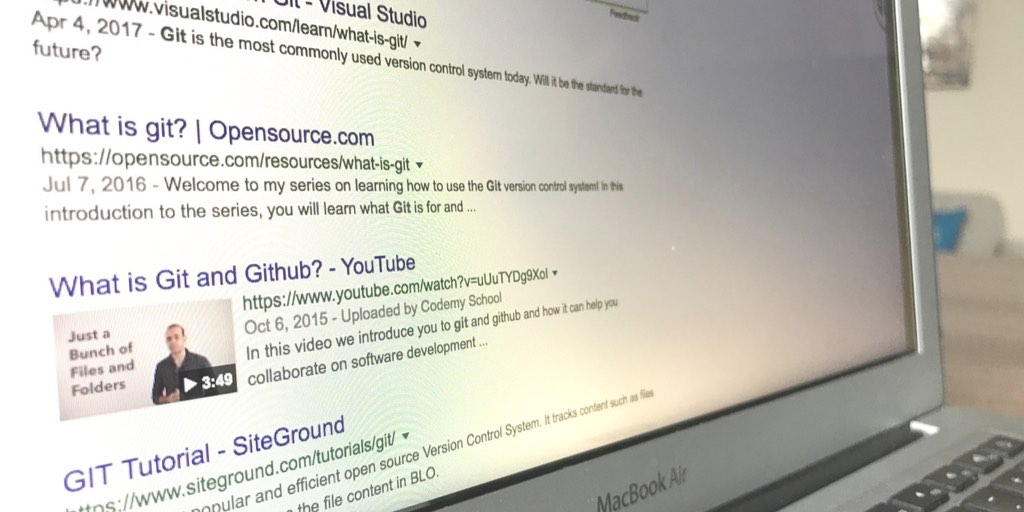How Certified Content Consistently Delivers “Better-Than-The-Best” SEO Content
I’m asked a lot of questions about SEO and content optimization, but if there’s one that encompasses the desires and frustrations of many clients, it is this: Why is it so difficult to create SEO content that ranks well and produces lots of organic traffic?
The simple answer is that there are already thousands of pages of online content for every need that a user brings to organic search. Your content must be better than all of them in order to rank well and drive organic traffic.
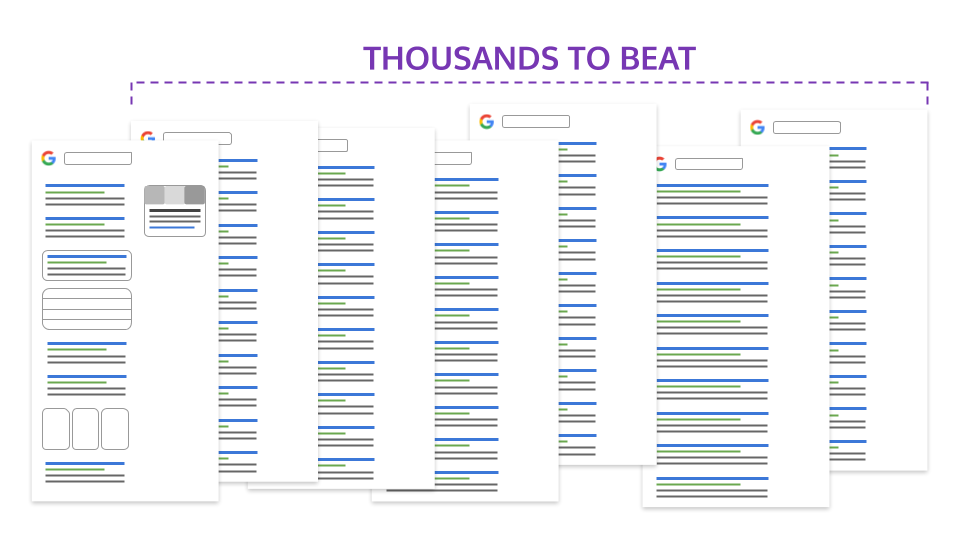
At Profound Strategy, the unique way we approach SEO means we produce reliable, consistent, scalable organic traffic growth. We do this by creating content through a tested, predictable process that looks at user needs, not just keywords.
What is a User Need in Organic Search?
A user need is a specific need that a user has, at a specific point in the buyer’s journey, that inspires an organic search query.
The search query demands specific information, which may be a sales or solutions page, a whitepaper, a blog post, a landing page, or something else. It may include subtopics that the user will want to read about, or content qualities that communicate value—such as site authority, timeliness, or use of media.
Often, the user might not know the specifics of what he’s looking for, but Google knows what the user will most likely prefer.
Because Google’s algorithms have matched content to that particular search query hundreds of thousands of times already. It has learned what specific content is most helpful to people using that search term, and what the user will most likely respond to and engage with.
What a User Need is Not
A user need is different from a topic, which is broad and unspecific. The topic “data silos,” for example, could have dozens of user needs associated with it—such as “what is a data silo,” “why are data silos problematic,” “are data silos and information silos the same thing,” etc.—but the topic “data silos” doesn’t tell us what the user really needs.
A user need also is different from user/search intent, or what Google calls “micro-moments”—the “intent-rich moments when a person turns to a device to act on a need: to know, go, do, or buy.”
- “Know” and “do” indicate that the user is looking for information on a topic, signifying a learn intent.
- “Buy” signifies a purchase intent.
- “Go” usually signifies a user who is trying to navigate somewhere or is looking for local recommendations.
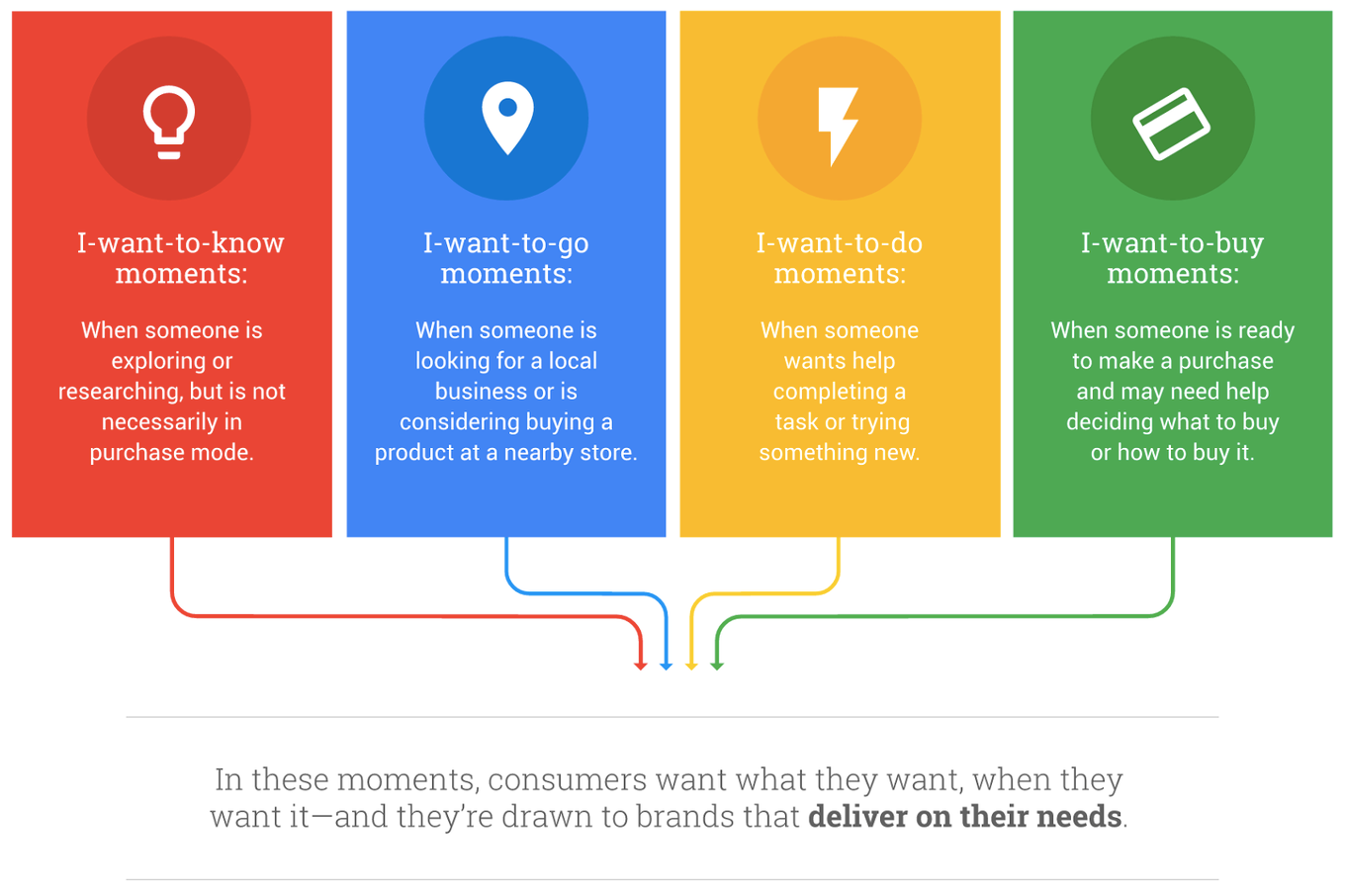
But knowing the user intent of a keyword or search term is not enough to understand the user need, which is more precise. A keyword with a “know” intent may represent more than one user need.
Keyword, Micro-Moment, or User Need?
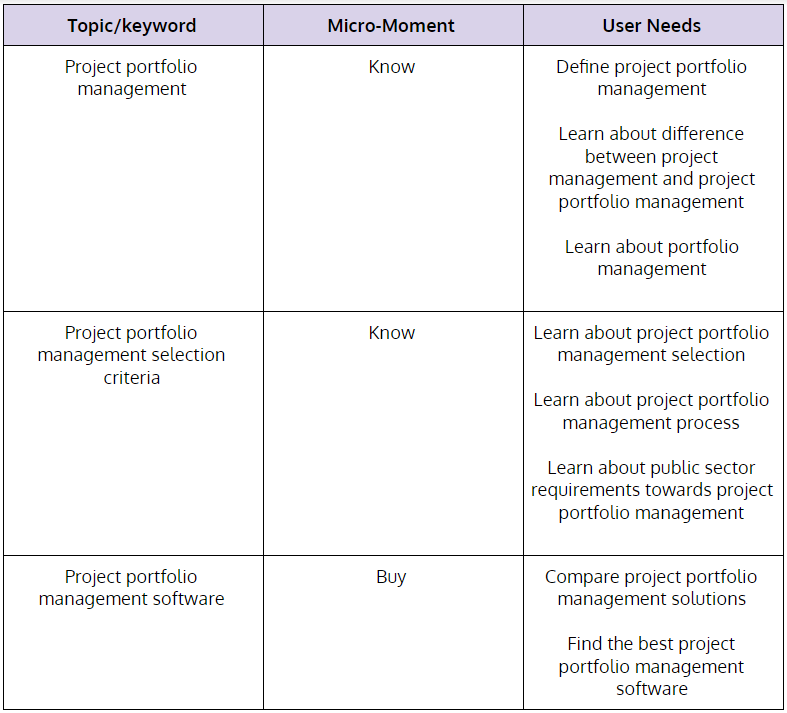
Content planned around a keyword may or may not be helpful to a reader. But content planned for a specific user need will be helpful to a reader, because it is designed for the reader from the ground up.
SEO Keywords are No Longer Enough
Many marketers have worked with keyword lists in the past. They, or their SEO agency, probably compiled a massive list of keywords with the idea of writing content for the ones deemed most important for the business.
This scenario usually falls apart when a marketer realizes they can’t possibly write a piece of content for each and every important keyword, and there are more questions than answers:
- If there are 200 important keywords, do we really need 200 pieces of content?
- When should we write a single piece of content for a group of keywords?
- When do we write two pieces of content for two similar keywords?
- Which of these keywords will have the most impact/drive the most traffic if we write a piece of content for it?
In fact, there are concrete answers to each of those questions, but keyword research alone is not the best way to create value with SEO. The only way to learn the answers to the questions above—and produce content that drives organic traffic and consistently outperforms competitors—is to follow a process that centers on a user need, not on a keyword.
How to Identify a User Need
Profound Strategy has a powerful backend user need tool that we use for clients, but, with a little more time, identifying a user need can be done manually, too.
Here are the important steps in the user need discovery process:
1. Conduct a depersonalized search for a core keyword.
2. Review organic results to determine the question(s) they answer. In the example below, we entered the keyword “project portfolio management”:
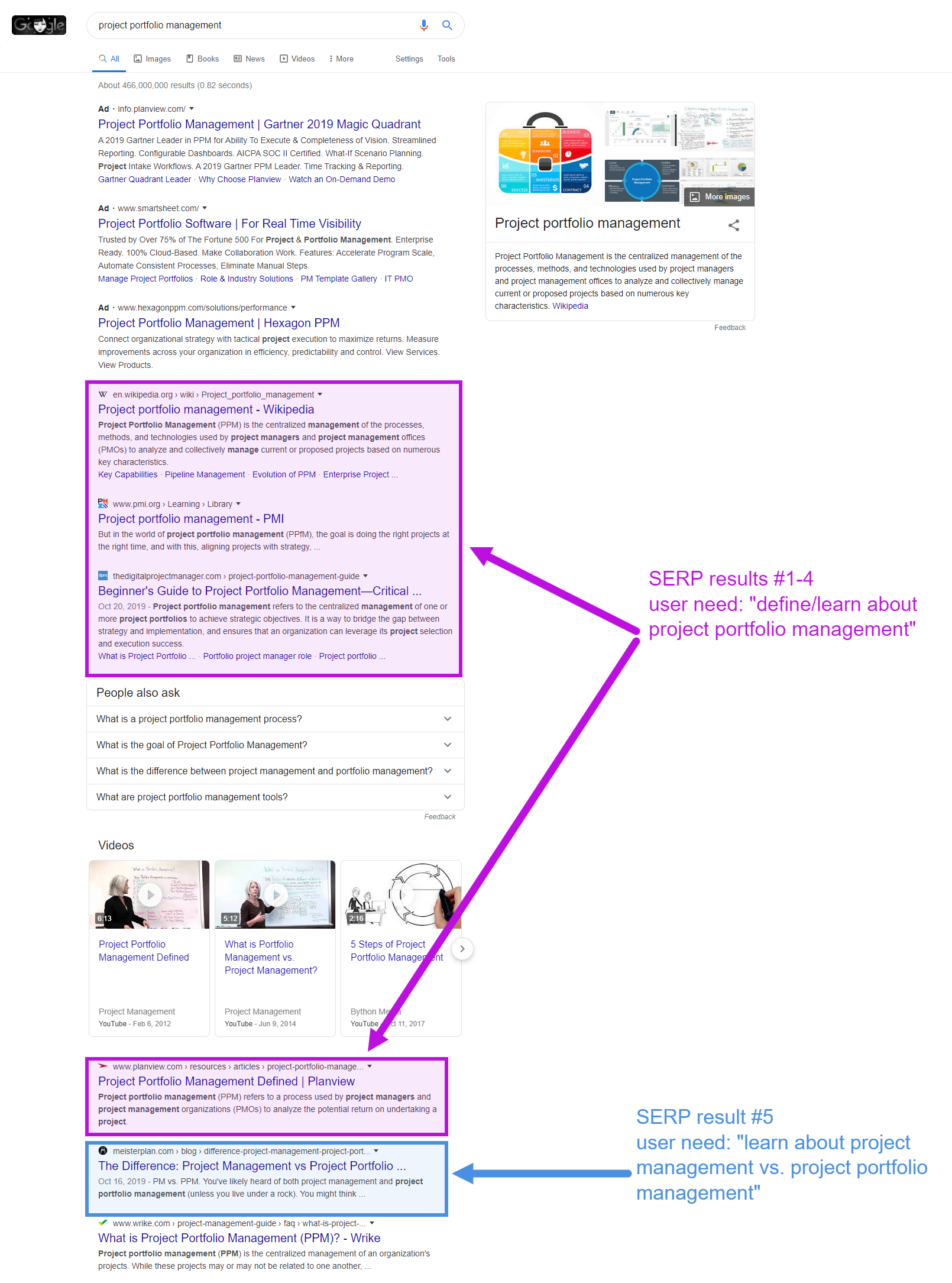
3. Repeat with similar, related keywords to see which terms produce similar results. You can then start to make a list of keywords that all produce organic results indicating the same user need.
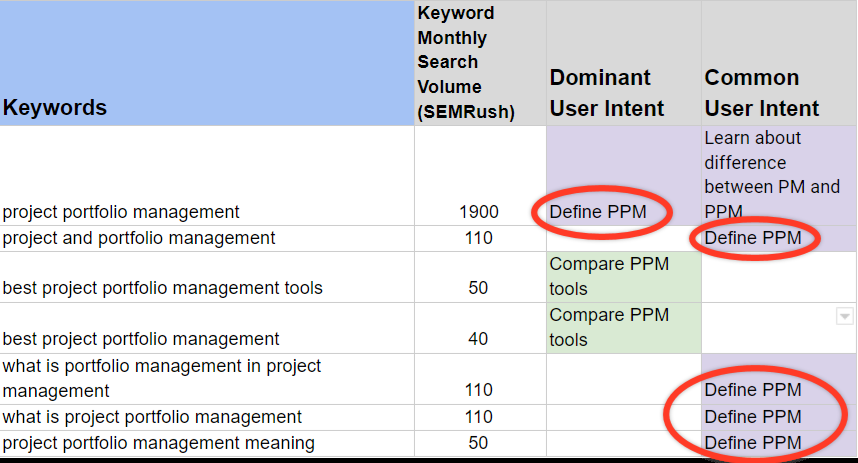
In this example, we have five keywords that produce SERPs where search results contain content focused on defining project portfolio management. So, we’d create a piece of content to specifically address the “define project portfolio management” user need.
4. Obtain the estimated search volume for those URLs from a tool like SEMRush or SEOClarity, to learn which ones have the largest search volume. Those are the top performers, the ones that usually appear in positions #1 through 3 in the SERPs. Those are the ones to beat.
SEO Research: Study the Top Performers
Now that you know who the top performers are, what is this telling you?
Google’s algorithm has experimented with sending traffic to hundreds of thousands of different articles and, out of all those experiments, Google has determined that these top performers contain the content that best meets this user need.
How does Google know what content is the best? Metrics that we don’t see, and to which we have no access, are what Google looks at, and many of them fall under the umbrella of user experience:
- How many searches did the user perform?
- How many times did the user re-word or edit a search?
- How long did users spend reading the content?
- Where did the user go after exiting the website?
Our process for studying the highest-ranking, traffic-generating content is called search intelligence. It involves examining every part of the top-performing content to learn about the content itself and how it is presented.
Some of the things we look at include:
- What do the top-performing pieces of content talk about?
- How do they approach the topic? What’s their angle?
- Is the content long and thorough, or short and to-the-point?
- Are there a lot of visuals or custom images, or is it mostly text?
- Does the top content include lists, tables, video, photos, gifs?
- How recently was the content published?
- Does the content include lots of internal links? External links?
Take the answers to those questions and use them to start outlining and planning your own content for that user need. Then, figure out how to use your brand’s unique voice, positioning, and insights to make it even more helpful and engaging than the content produced by competitors.
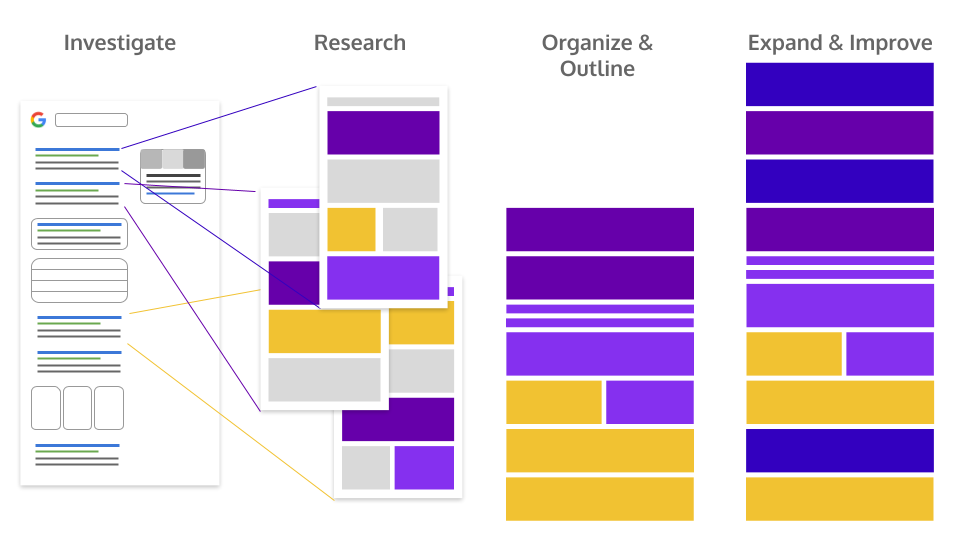
Consider:
- Creating the ultimate resource — You may want to combine subtopics from other top content to create one ultimate guide (if long-form content is winning).
- Adding what’s missing — Just because the top content is missing something doesn’t mean you shouldn’t include it. If you have a great video, and no one else has included a video, embed it in your content and improve over the competition.
And, of course, include your brand’s UVP, unique insights, and voice.
What to Expect from Effective SEO: Gradual, Continued Growth
Even the best content doesn’t jump to #1 on the SERP and begin generating massive amounts of organic traffic in the first few days or weeks, because authority in organic search has to be earned. Organic traffic should increase gradually, and it should continue to grow over months and years.
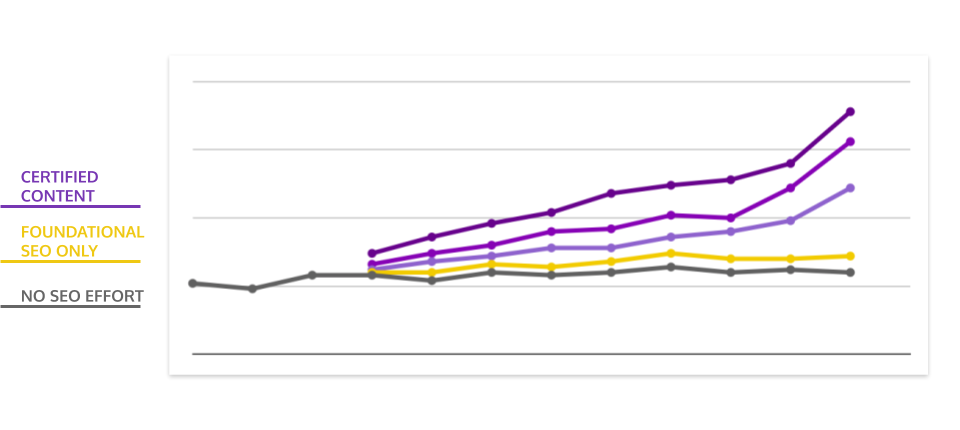
Watch your content for three to six months. If you don’t see steady traffic growth after six months, it may be time to start over. If traffic from organic search does not continue to grow, or if it flattens/declines, or if you’re getting no traffic at all, you might have a technical SEO issue to address. But what’s far more likely is that your content is not as good as what’s already out there.
The SEO Content Strategy that Works
Profound Strategy has a specific process around this approach to writing content. It’s called certified content, and we’ve produced hundreds of pieces of content according to this strategy.
Certified content is SEO content based on a distinct organic search research process, drafted according to modern SEO and content best practices, and refined in partnership with the client’s internal experts.
The results are so reliable that we actually built a forecast model based on the total, combined search volume for a user need. We know what kind of organic growth to expect from a piece of certified content. If a new piece of content performs well against the model, we know it will see continued growth over time.
A Clear Path to SEO Growth
Great content that ranks well and delivers organic traffic will always be challenging to produce, mainly because there is so much content that already exists. Keywords and keyword lists are just the beginning of a comprehensive content creation process. A clear path to reliable, scalable SEO growth starts with content that addresses a single, clear user need, and does it better than everyone else.
This process is more intense than most marketers are used to when it comes to creating SEO content. But what most marketers are used to probably isn’t driving rankings and traffic. Want to learn more about how Profound Strategy can help you craft SEO-certified content that can stand the test of time? Contact us to speak with one of our SEO strategists today.
What's Next?
Profound Strategy is on a mission to help growth-minded marketers turn SEO back into a source of predictable, reliable, scalable business results.
Start winning in organic search and turn SEO into your most efficient marketing channel. Subscribe to updates and join the 6,000+ marketing executives and founders that are changing the way they do SEO:
And dig deeper with some of our best content, such as The CMO’s Guide to Modern SEO, Technical SEO: A Decision Maker’s Guide, and A Modern Framework for SEO Work that Matters.

